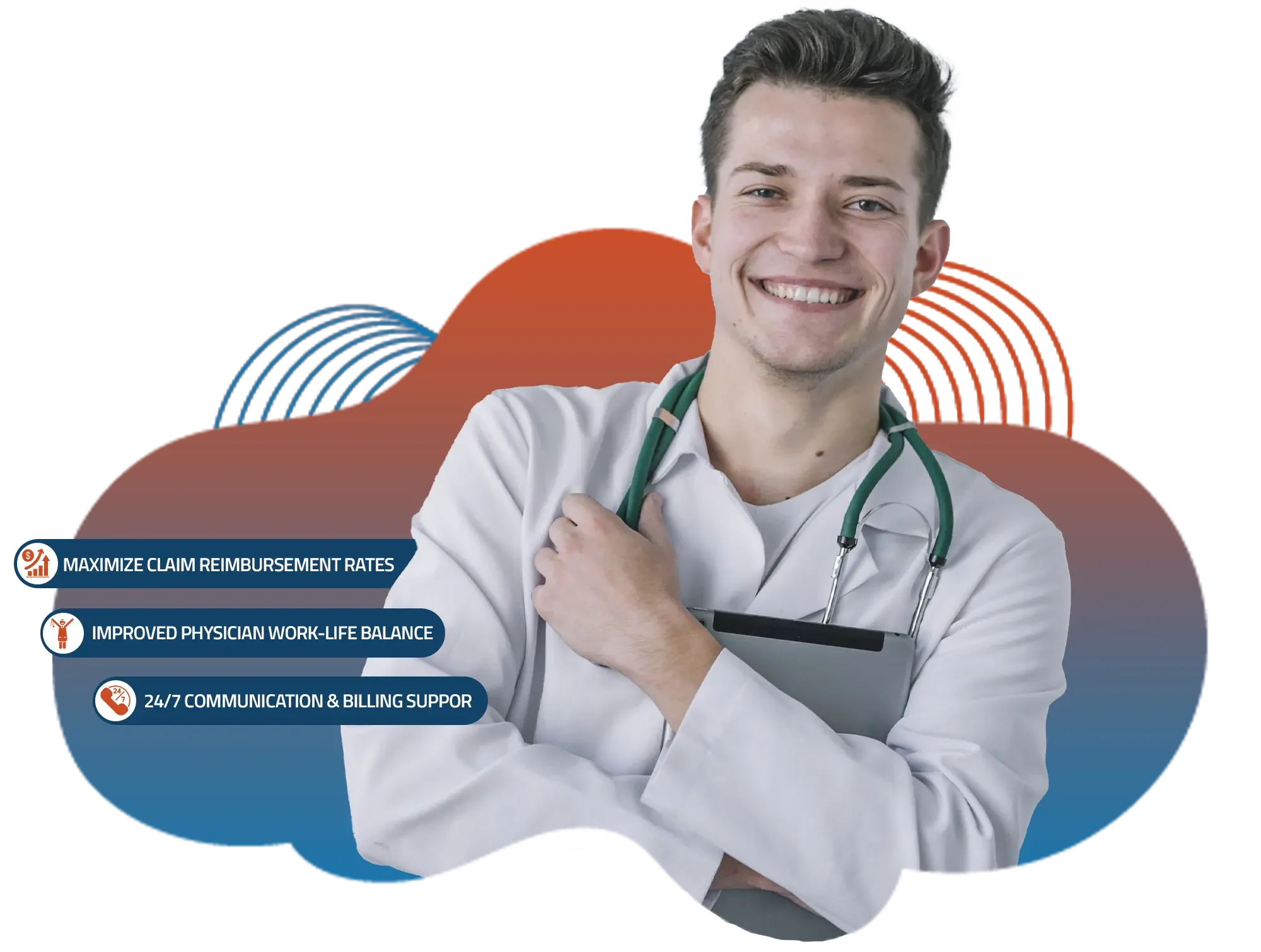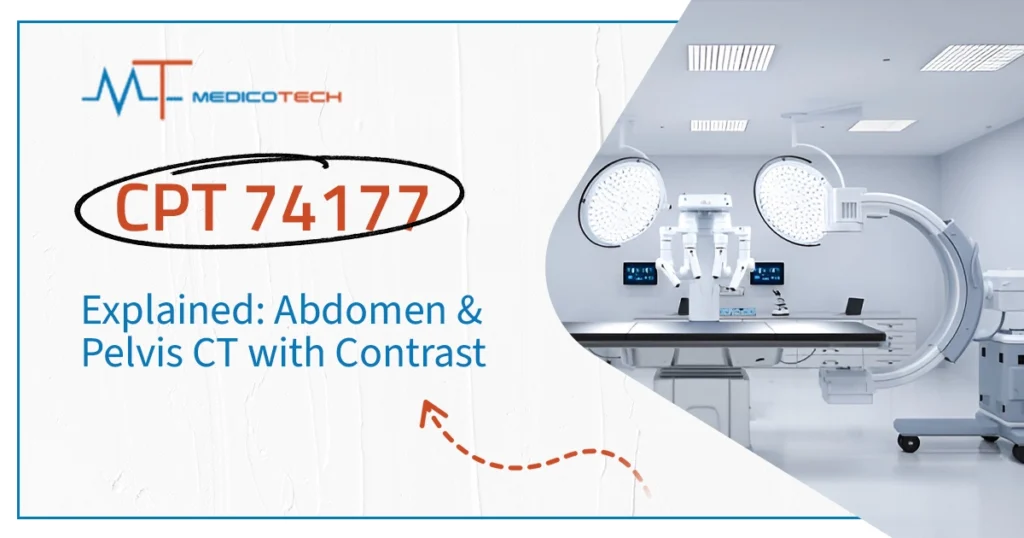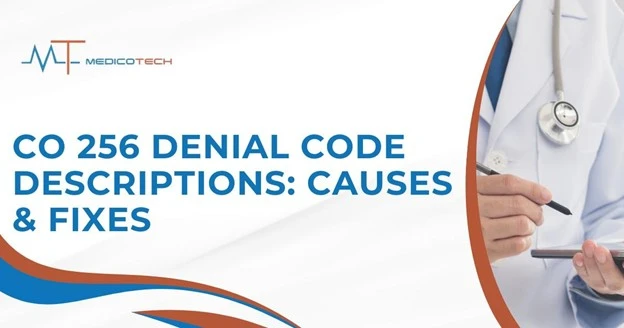Introduction to CPT Code 74177
Definition and Purpose of CPT Code 74177
CPT Code 74177 refers to a computed tomography (CT) scan of the abdomen and pelvis with contrast material. This imaging procedure is used by healthcare professionals to diagnose various conditions in the abdominal and pelvic regions. The addition of contrast material enhances the visibility of organs, blood vessels, and tissues, providing clearer, more precise images that are crucial for evaluating conditions such as tumors, infections, inflammation, and injuries. By using contrast material, the CT scan offers improved diagnostic accuracy, making it an essential tool for clinicians.
What is CPT Code 74177?
Overview of the Procedure and Its Uses
CPT Code 74177 is specifically used when a CT scan of the abdomen and pelvis is performed with contrast material. The procedure captures detailed cross-sectional images of both areas, which helps doctors identify and assess conditions such as:
- Cancer: Identifying tumors and assessing their size, location, and spread.
- Trauma: Evaluating injuries to organs or structures in the abdomen and pelvis.
- Infections: Detecting abscesses, fluid collections, and other infections.
- Inflammatory Diseases: Assessing conditions like diverticulitis, appendicitis, and ulcerative colitis.
- Abdominal Pain: Diagnosing the underlying causes of unexplained abdominal pain.
By using contrast, clinicians gain better visibility into internal organs such as the liver, kidneys, and intestines, enhancing diagnostic precision.
Importance of Contrast Material in the Procedure
Contrast material is crucial for improving the clarity of CT images. When injected intravenously (IV), the contrast helps delineate blood vessels, soft tissues, and the gastrointestinal tract. This allows healthcare providers to identify issues that might be missed without contrast, such as small tumors or internal bleeding. The role of contrast in this procedure is vital for improving diagnostic accuracy and ensuring that the proper diagnosis and treatment plans are implemented.
Coding Guidelines for CPT Code 74177
Key Coding Guidelines for Proper Reporting
To correctly report CPT Code 74177, healthcare providers must ensure they follow the coding guidelines set by the American Medical Association (AMA). These guidelines help ensure consistent and accurate use of the CPT code. Key considerations include:
- Ensure Both Abdomen and Pelvis Are Imaged: CPT 74177 is used only when both regions are imaged with contrast material.
- Document the Use of Contrast: It is essential to specify that contrast material was used during both the abdominal and pelvic scans. Without this documentation, the use of CPT code 74177 would not be appropriate.
Documentation Requirements for CPT Code 74177
Accurate documentation is vital for proper billing and ensuring reimbursement. The documentation should include the following:
- Indication for the Scan: Clear reasons for performing the CT scan, such as suspected cancer, trauma, or unexplained pain.
- Type of Contrast Material Used: Whether intravenous (IV) or other forms of contrast.
- Findings: Detailed results from the scan, including any diagnoses like tumors or inflammation.
Proper documentation not only supports the medical necessity but also ensures compliance with insurance and reimbursement guidelines.
Modifiers for CPT Code 74177
Common Modifiers Used with CPT Code 74177
Modifiers are essential for providing additional information about the procedure, particularly when the professional and technical components are handled by different providers. Here are some commonly used modifiers for CPT Code 74177:
- Modifier 26 (Professional Component): This modifier is used when only the interpretation of the CT scan is performed, without the technical aspects like scanning and image acquisition.
- Modifier TC (Technical Component): Used when only the technical aspects of the CT scan are provided, including the use of equipment and administering contrast.
- Modifier 59 (Distinct Procedural Service): If a CT scan is performed alongside another procedure that isn’t typically reported together, Modifier 59 is used to indicate that the procedures are distinct and separate.
When and How to Apply Modifiers (e.g., Modifier 26, TC, Modifier 59, etc.)
Modifiers should be applied based on the specific circumstances of the CT scan. For example:
- Modifier 26 should be used when the physician provides the interpretation of the scan but not the imaging.
- Modifier TC is applied when the radiology Billing facility performs the technical components (e.g., the scan itself) but not the interpretation.
- Modifier 59 can be used when performing a distinct and separate CT scan on the same day as another procedure.
It’s essential to check payer-specific guidelines for how to apply these modifiers correctly to avoid claim denials.
Medicare Reimbursement for CPT Code 74177
Medicare Payment Structure and Reimbursement Rates
Medicare typically reimburses for CPT Code 74177 as part of its Physician Fee Schedule (MPFS), but the actual reimbursement can vary depending on several factors, including geographical location and specific contractual agreements. Medicare will generally cover the procedure when it is deemed medically necessary, as outlined in the patient’s records and the relevant clinical guidelines.
Factors That Impact Reimbursement
Several factors can impact the reimbursement rates for CPT 74177, including:
- Location: Reimbursement rates may differ across regions, with urban centers often having higher rates compared to rural areas.
- Payer Contracts: Providers should be familiar with their individual contracts with Medicare or other private insurers to understand the specific reimbursement rates for this code.
- Medical Necessity: Medicare will only reimburse for CPT 74177 if the scan is deemed medically necessary, with sufficient documentation to justify the need for the procedure.
Providers should always verify with their Medicare Administrative Contractors (MACs) to ensure compliance and ensure that the procedures are covered.
Reimbursement for CPT Code 74177
Reimbursement Insights Based on Payer and Location
While Medicare provides clear guidelines for reimbursement, private insurers may have different payment structures. It’s crucial for healthcare providers to:
- Check with individual insurance companies: Reimbursement rates may vary by payer.
- Consider geographical factors: Different regions may have different payment rates, particularly in urban versus rural areas.
How to Maximize Reimbursement
To ensure you receive proper reimbursement for CPT Code 74177:
- Verify medical necessity with comprehensive patient documentation.
- Apply the correct modifiers where necessary to capture the correct components of the service.
- Review payer-specific guidelines regularly to stay updated on changes in reimbursement policies.
How to Maximize Reimbursement for CPT Code 74177
Maximizing reimbursement for CPT Code 74177 requires more than just proper coding and documentation; it involves a strategic approach to understanding payer requirements, ensuring the medical necessity of the procedure, and minimizing errors in the billing process. Here are key strategies to maximize reimbursement for CT scans of the abdomen and pelvis with contrast (CPT 74177):
1. Verify Medical Necessity
Ensure that the procedure is medically necessary. Document clear and thorough indications for performing the CT scan, including symptoms, medical history, and the reason for using contrast material. The procedure must be justified based on clinical signs or conditions such as abdominal pain, trauma, or suspected cancer. This helps avoid claim denials and improves reimbursement chances.
2. Apply the Correct Modifiers
When appropriate, apply modifiers like Modifier 26 (Professional Component) for the interpretation of the scan or Modifier TC (Technical Component) for the imaging procedure. Accurate application of modifiers clarifies the services provided and helps to differentiate between the professional and technical aspects of the procedure, ensuring full reimbursement.
3. Be Familiar with Payer-Specific Guidelines
Different insurance companies, including Medicare and private payers, have specific reimbursement rates and policies for CPT 74177. Stay up-to-date with these guidelines, particularly for medical necessity and documentation requirements, to avoid underpayment or denials. Ensure your practice follows payer-specific coverage requirements and understands reimbursement rates for each insurer.
4. Leverage Electronic Health Record (EHR) Systems
Use your EHR system to streamline the coding and documentation process. EHR systems can help ensure that all necessary information is captured for the procedure, improving accuracy and reducing the chances of human error during billing. Many EHR systems also provide alerts for missing documentation, helping ensure claims are submitted on time and without missing elements.
Coverage Criteria for CPT Code 74177
Understanding payer-specific coverage criteria is essential to ensuring that CPT code 74177 is reimbursed correctly. Insurance companies and Medicare may have specific criteria that must be met before coverage is approved. Here’s what you need to know:
Payer-Specific Coverage Requirements
Each payer will have its own guidelines for what is considered medically necessary and therefore eligible for reimbursement. These guidelines typically involve:
- Indications for the CT scan: Different insurers may have specific conditions under which a CT scan with contrast of the abdomen and pelvis is deemed necessary, such as trauma, cancer diagnosis, abdominal pain, or suspected inflammatory diseases.
- Frequency limits: Some insurance providers may limit the number of CT scans a patient can receive within a specific period, based on their diagnosis or condition. Providers should be aware of these limits to avoid submitting claims that will be denied.
- Prior Authorization: Some insurers or Medicare may require prior authorization for CPT code 74177, particularly for high-cost procedures like CT scans with contrast. Always confirm the need for authorization before proceeding with the scan.
Verifying Medical Necessity and Coverage for Reimbursement
Before submitting a claim for CPT 74177, ensure that:
- Documentation supports medical necessity: Include a detailed clinical justification for why the CT scan is needed. The reasons should match the insurance guidelines for the procedure.
- Check payer policies: Different insurers have different coverage policies, and failure to adhere to these can result in denials. Always verify with each payer before performing the procedure.
- Use the correct diagnosis codes: Ensure that the diagnosis code(s) align with the insurance payer’s guidelines. This is crucial for demonstrating medical necessity and facilitating smooth reimbursement.
Billing Guidelines for CPT Code 74177
Adhering to billing guidelines for CPT Code 74177 helps reduce errors and ensures timely reimbursement. Here are some best practices for effective billing:
Best Practices for Billing CPT Code 74177
- Correct Coding: Ensure that CPT 74177 is used for a CT scan of the abdomen and pelvis with contrast. Double check that contrast material was actually used during the procedure. If it was not, a different CPT code should be used.
- Modifiers: Use appropriate modifiers such as Modifier 26 for professional services and Modifier TC for technical services when applicable. If there are additional procedures performed during the scan, Modifier 59 should be used to indicate distinct services.
- Accurate Diagnosis Codes: Select the correct ICD-10 codes that align with the indications for the CT scan. Be sure to include codes for abdominal or pelvic conditions that are consistent with the patient’s clinical presentation.
Timely Submission and Documentation for Accurate Billing
- Submit Claims Promptly: Submit claims for CPT 74177 as soon as possible to avoid delays in reimbursement. Timely submission is critical for maintaining cash flow and minimizing administrative costs.
- Ensure Accurate Documentation: Double-check that all required documentation (e.g., signed physician orders, clinical notes, radiology reports) is included with the claim. Accurate documentation supports the medical necessity and helps prevent denials or rejections.
Common Pitfalls in Billing and Documentation for CPT Code 74177
Billing and documentation errors are a common reason for claim denials. Here’s how to avoid them:
Avoiding Common Errors in Billing and Documentation
- Incorrect Use of CPT Code: Ensure CPT 74177 is used only for CT scans of the abdomen and pelvis with contrast. Misusing this code for scans without contrast or incomplete procedures could lead to claim denials.
- Missing Documentation: Failure to include a signed order for the CT scan or the absence of a radiology report can result in non payment. Always include the appropriate medical records that show the justification for the CT scan.
- Incomplete Modifier Application: Incorrectly applying modifiers can lead to underpayment or rejection. Ensure that the modifier 26 and modifier TC are applied correctly, and modifier 59 is used when needed.
Ensuring Compliance with CPT Code 74177 Reporting
Ensure that:
- Documentation is complete and contains all necessary information, including the clinical indication, contrast use, and findings.
- Modifier use is compliant with payer requirements.
- Reimbursement policies for the specific payer are followed precisely to avoid errors.
Tips for Properly Documenting CPT Code 74177
Accurate documentation is essential for proper billing and reimbursement. Here’s how to document CPT Code 74177 effectively:
Essential Elements to Document for Accurate Billing
- Clinical Indication: Clearly document why the CT scan is being ordered. Include symptoms, history, or conditions that justify the need for a contrast-enhanced CT scan.
- Contrast Material Used: Specify that contrast material was administered, including the type and method (e.g., intravenous contrast). This distinguishes CPT 74177 from other CT scans without contrast.
- Findings: Include any specific findings from the scan, such as tumor size, organ abnormalities, or signs of inflammation. These help justify the necessity of the procedure.
Importance of Clear and Detailed Documentation
- Completeness: Ensure all required details are included, such as the reason for the scan, the use of contrast, and the findings.
- Accuracy: Double-check that all information is accurate and matches the clinical indications for the procedure. Errors or omissions can lead to delays in reimbursement or denials.
- Compliance: Ensure that documentation complies with payer requirements and follows the guidelines set by insurance companies and Medicare.
Frequently Asked Questions (FAQs)
What are the common questions about CPT Code 74177?
- Q: When is CPT Code 74177 used?
- A: CPT Code 74177 is used for a CT scan of the abdomen and pelvis with contrast material. It helps diagnose conditions like tumors, infections, or abdominal pain.
- A: CPT Code 74177 is used for a CT scan of the abdomen and pelvis with contrast material. It helps diagnose conditions like tumors, infections, or abdominal pain.
- Q: Do I need to use modifiers for CPT 74177?
- A: Yes, modifiers like Modifier 26 for professional services or Modifier TC for technical services are often necessary. Additionally, Modifier 59 may be used if a distinct procedural service is performed.
- A: Yes, modifiers like Modifier 26 for professional services or Modifier TC for technical services are often necessary. Additionally, Modifier 59 may be used if a distinct procedural service is performed.
- Q: How do I ensure correct reimbursement for CPT 74177?
- A: Ensure that documentation supports medical necessity, apply the correct modifiers, and verify payer-specific coverage requirements before submitting the claim.
- A: Ensure that documentation supports medical necessity, apply the correct modifiers, and verify payer-specific coverage requirements before submitting the claim.
Conclusion
CPT Code 74177 is a critical procedure used for diagnosing a range of conditions affecting the abdomen and pelvis. By following the appropriate coding guidelines, understanding payer-specific coverage criteria, and applying the correct modifiers, healthcare providers can maximize reimbursement and minimize claim denials. Proper documentation is key to ensuring that the procedure is billed correctly and meets medical necessity requirements. By following best practices for billing and documentation, you can ensure accurate reimbursement for your CT scans.




